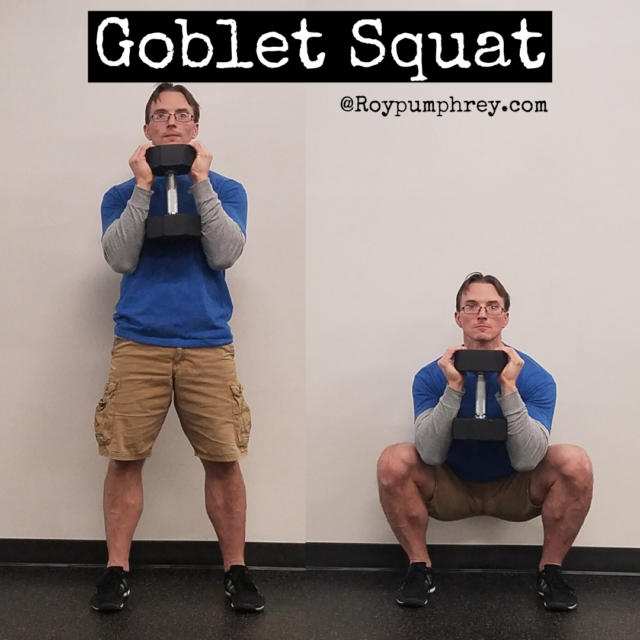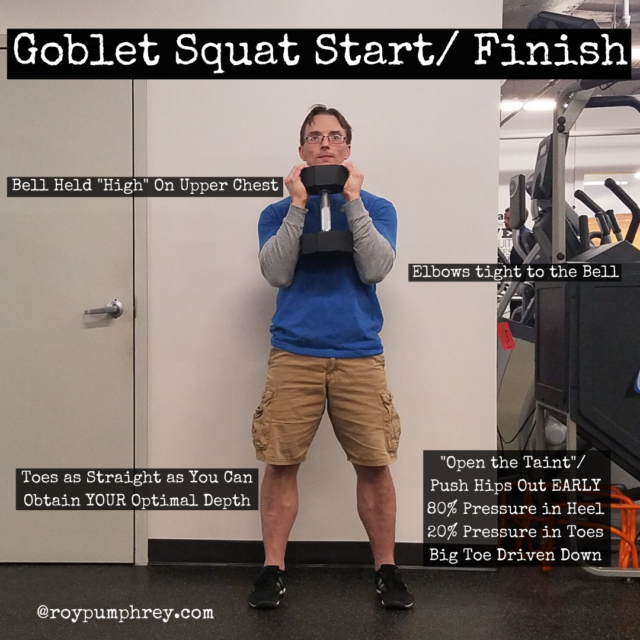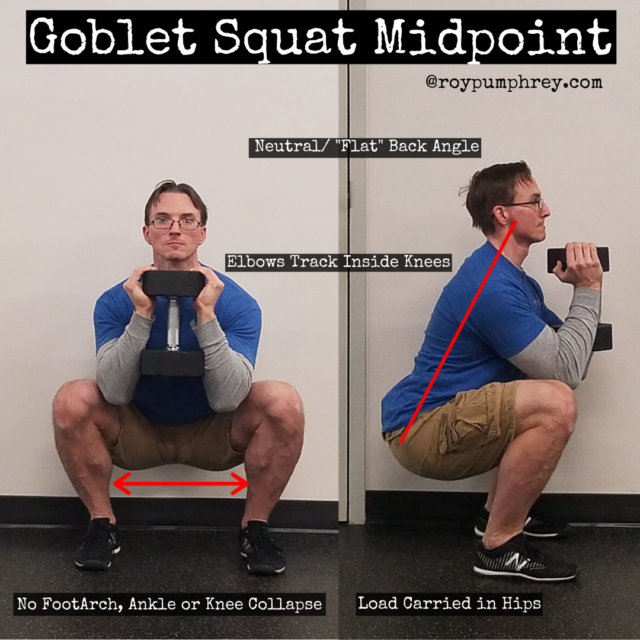
Squat: The King of All Exercises
That’s what the squat has been called.
Why?
Well, a good, heavy, squat works, well, EVERYTHING.
From top to bottom:
Upper Back:
Gotta keep the mid back (rhomboids), lats, traps TIGHT AF through the movement to maintain upper torso stability. <—you NEED to be LOCKED INTO the bar. You DO NOT want to be balancing the bar on your upper back.
Grip:
At least in the back squat and Kettlebell Goblet Squat.
Better be CRUSHING the bar to tighten the whole body and help keep that bar in place.
Core:
Lot’s of people who have never squatted anything relatively challenging will tell you,
“squats don’t work the core”
Those people just told you they’ve never squatted anything even mildly difficult.
When a 6RM back squat was compared to a prone plank with an added 20% of body weight,
“squatting resulted in greater erector spine activation, but similar rectus abdominis and oblique external activation as the prone bridge. Typically, specific core exercises are performed isometrically in the horizontal position, attempting to isolate the different core muscles, which does not mimic movements in sport or daily living activities. For daily living activities (e.g. stair climbing, walking, lifting, throwing, kicking etc), injury prevention, and performance improvement, we recommend targeting core muscles by integrated high-intensity exercises as the squat instead of an isolated and isometric core exercise, especially for athletes. The present study found no advantages of performing the prone bridge compared to squatting.” – Comparison of Core Muscle Activation between a Prone Bridge and 6-RM Back Squats
And a review of the literature regarding muscle activation during squatting concluded,
“At loads of greater than 50% of 1RM, the back squat to parallel is an effective method of developing trunk activation and therefore arguably trunk stability.”- Muscle Activation in the Loaded Free Barbell Squat: A Brief Review
And when squats (SQ) and deadlifts (DL) were compared to stability ball exercises for the core,
“When the goal of a training program is to increase muscular strength and hypertrophy of the back extensors, strength and conditioning coaches and rehabilitators may find it more beneficial to include the SQ and DL exercises rather than stability ball exercises.“- Trunk Muscle Activity During Stability Ball and Free Weight Exercises
So heavy(ish) squatting is at least as good at activating the “core” musculature as most core specific training.
Anyone who has been folded over when squatting intimately understands the words of powerlifting Yoda (Lou Simmons),
“You squat 300lbs cause you’ve got 600lbs legs but a 3oolbs core” – Lou Simmons
*All this said, I WOULD NOT throw out core specific training.
Legs:
Of course the legs.
Quads and glutes especially, usually not so much the hamstrings, at least not until you get heavy…
But don’t neglect the hammies, they sometimes get poo pooed in regards to the squat because studies consistently find there is little to no hamstring hypertrophy with squatting and lower levels of muscle activation
“Regarding the hamstring muscles, FST (full depth) and HST (half depth) did not increase muscle sizes. Previous studies showed that the activation levels of the hamstring muscles measured by electromyography and magnetic resonance imaging were lower during squat exercises regardless of the squat depth As a reason for the weaker activation of the hamstring muscles during squat exercises, Sugisaki et al.(2014) indicated that there was no change in the lengths of the hamstring muscles, and, thus, these muscles contract almost isometrically. Other researchers also indicated that squat training did not provide a sufcient training stimulus for the hamstring muscles (Ebben 2009; Wright et al. 1999). Bloomquist et al. (2013) showed that the cross sectional area of the hamstring muscles did not change after 12 weeks of full and shallow squat training. Taking these previous findings into account together with the present results on the hamstring muscles, squat training regardless of depth was insufficient to induce hypertrophy of the hamstring muscles“ – Effects of squat training with diferent depths on lower limb muscle volumes
Hamstrings may play a vital role in knee stability and maximizing hip torque and hip extension forces at near maximal loads.
“The hamstrings have been reported to be active in the concentric phase of loaded squatting tasks. Co-contraction of the quadriceps and hamstrings would seem to be counterproductive because the hamstrings exert a flexor torque at the knee. However, this co-contraction may be beneficial in the squat as it is a multi-joint task. As the knee extends, the force acting on the co-contracting hamstrings is transferred to the hip, assisting with the hip extension. The hamstrings have a smaller lever arm at the knee than at the hip, and therefore, for the same force in the muscle, the flexor torque at the knee is less than the extensor moment at the hip. Waters et al. have also reported that the hamstrings contribute 45 to 55% of the maximum torque generated by the hip extensors. Therefore, if the hip extensor RME (relative muscular effort) exceeds 45 to 55% MVC (max voluntary contraction), as was observed in this investigation, it would not be possible to generate hip extensor torque without activating the hamstrings. As the hamstrings co-contract with the quadriceps, the knee extensor NJM (net joint movement) will underestimate the torque generated by the quadriceps. Thus, quadriceps RME should be higher than the knee extensor RME during loaded squats.”- Effect of Squat Depth and Barbell Load on Relative Muscular Effort in Squatting
This is probably a VERY similar situation to what we see with the lats in benching.
The hamstrings probably ain’t doing much really until the loads get relatively heavy (80% and above) because below that level of loading the quads can keep the knee joint stable and the glutes can do enough to extend the hip.
However, once we break that % of 1RM threshold (whatever it is) where the hips need help extending and the joint instability increases due to near 1RM loading, the co-contraction at the knee joint to maintain joint centration must increase and you’re going to wish you had trained more hammies.
Back Squats= Bad Knees, Hurt Elbows, Janky Shoulders and Sore Backs:
That’s the common knock on the back squat and some of it is rightly deserved.
Using the barbell locks you into place.
It’s not very forgiving.
If you lack mobility or are very muscular in the upper body you could have a REALLY hard time getting under the bar and establishing a good upper body position.
Poor core control and you’re probably going to overarch the low back and have a good amount of the bad kind (in the spine, ligaments, disks and tendons) back pain. #HELLOL4-L5-S1
Weak upper back and you’re getting rounded over risking a low back herniation.
No awareness of the glutes, creating hip torque (femoral external rotation) ie opening the taint, and knee position is a recipe for valgus collapse, hip shift, the development of a really poor motor pattern and potentially increased risk of knee, hip and low back injury.
For the very reason that YOU must conform to the barbell, long ago I heard the phrase,
The Barbell is a Tool of Satan
Even though barbells are super awesome and will help you get hella strong, it kinda is #notgettingridofmine
So this becomes a problem when you’re trying to teach people to squat for a number of reasons.
First off, many people tend to have an inherent fear of squatting because they’ve been told how it destroys knees and backs.
While 99/100 times the most accurate retort to this fear is,
“Squatting doesn’t destroy knees and backs, what YOU did and called it a squat destroyed your knees and back”
That doesn’t get most people past their fears.
Which leads into the next point,
Poor Technique and Conceptions of What Good Technique is,
Heads looking at the ceiling, hands all the way out on the barbell, no hip movement, heels coming off the ground, knees almost touching, bars on necks, squat pads…yes, people actually using using the tampon on the bar squatting.
All those are dead giveaways that, you’re technique and what you BELIEVE is good technique is a problem, it needs to be fixed and you don’t really know how to squat.
BTW, full disclosure, I’ve done ALL of those, many at the same time. You only know what you’ve learned…
I can’t tell you the number of times I’ve been told my max squat is (insert number that seems unrealistic) watched the person squat and their max squat, with proper technique, you know a real squat, is maybe (and usually less) than a third, 1/3rd what they told me their max was.
For most of these people getting back under a loaded bar is AN INCREDIBLY BAD IDEA.
So where to go from here?
How can we learn or relearn how to squat correctly in a easy, relatively safe way that trains all the relevant muscles, reinforces proper squat mechanics and is highly scalable and almost self correcting?
Glad you asked,
The Goblet Squat
Why Goblet Squat?
The position of weight is self limiting and self correcting.
With the weight positioned to the front and held high you MUST extend the thoracic spine and keep the chest up through the lift or you’ll drop the bell.
Elbows “close” to the bell promotes “knees out” or an “opening of the taint” because the knees need to move out at depth to accommodate the elbows.
This helps combat the dreaded knee and ankle and arch collapse.
Anterior loading helps increase the activation of the anterior core helping to lock in the “cylinder position”
I don’t have literature on this, but do a heavy goblet squat and you sure as hell can feel it.
On that point, as of right now I could find almost no literature on the goblet squat. Except These: How Should I Squat? and CHANGES IN BILATERAL WEIGHT DISTRIBUTION AND TRUNK KINEMATICS WITH THREE SQUAT VARIATIONS
For most people this higher core activation and “opening of the taint” (getting the head of the femur out of the way), “winding up” and activating the glutes, providing a stable pelvis to sit into when all put together tends to promote better torso angle and depth than other squat variations for most people.


Key Points:
- Weight high on the chest. <—-general rule is top of bell is under a neutral chin.
- Elbows “tight(ish)” to the bell.
- Head and eye position stays the same through the lift.
- Initiate by sitting BACK, not straight down.
- Elbows inside knees.
- Root the feet: Big toe driven down, 80% pressure on heel, 20% on toes and ball of foot.
- Chest up through the whole lift.
- Stand on HARD GLUTES at the top.
BRO Tips:
- Think “sit behind the knees”.
- Push the feet (hips) out and down (leave a big footprint).
- Don’t breathe all your air out at the top. If you MUST breathe out at all, 33% breaths.
- On that note, DO NOT BREATH OUT. Cycle breaths at the top. DO NOT BREATH OUT ON THE WAY UP. You’ll decompress the torso and lose rigidity and torso position.
- Make sure you pull breath into your belly not chest, think “fill the pelvis with air”
- DO NOT LEAN BACK AND REST ON YOUR LOWER BACK AT THE TOP. <—–Stand tall, hard feet, quads, abs, glutes.


